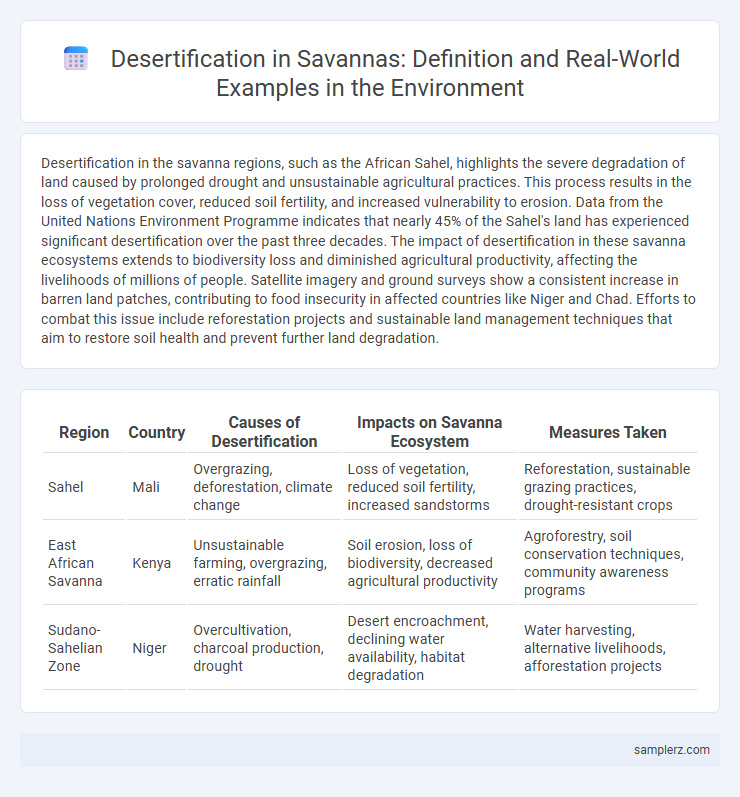Desertification in the savanna regions, such as the African Sahel, highlights the severe degradation of land caused by prolonged drought and unsustainable agricultural practices. This process results in the loss of vegetation cover, reduced soil fertility, and increased vulnerability to erosion. Data from the United Nations Environment Programme indicates that nearly 45% of the Sahel's land has experienced significant desertification over the past three decades. The impact of desertification in these savanna ecosystems extends to biodiversity loss and diminished agricultural productivity, affecting the livelihoods of millions of people. Satellite imagery and ground surveys show a consistent increase in barren land patches, contributing to food insecurity in affected countries like Niger and Chad. Efforts to combat this issue include reforestation projects and sustainable land management techniques that aim to restore soil health and prevent further land degradation.
Table of Comparison
| Region | Country | Causes of Desertification | Impacts on Savanna Ecosystem | Measures Taken |
|---|---|---|---|---|
| Sahel | Mali | Overgrazing, deforestation, climate change | Loss of vegetation, reduced soil fertility, increased sandstorms | Reforestation, sustainable grazing practices, drought-resistant crops |
| East African Savanna | Kenya | Unsustainable farming, overgrazing, erratic rainfall | Soil erosion, loss of biodiversity, decreased agricultural productivity | Agroforestry, soil conservation techniques, community awareness programs |
| Sudano-Sahelian Zone | Niger | Overcultivation, charcoal production, drought | Desert encroachment, declining water availability, habitat degradation | Water harvesting, alternative livelihoods, afforestation projects |
Overview of Desertification in Savanna Ecosystems
Desertification in savanna ecosystems primarily occurs due to prolonged drought, unsustainable agricultural practices, and deforestation, leading to the degradation of soil quality and loss of vegetation cover. This process reduces biodiversity and disrupts the balance of the savanna, transforming once-prolific grasslands into barren, arid landscapes. Key regions affected include parts of the Sahel in Africa, where desertification threatens both local wildlife and the livelihoods of millions dependent on these ecosystems.
Causes of Desertification in Savanna Regions
Savanna regions experience desertification primarily due to overgrazing, which depletes vegetation cover and exposes soil to erosion. Climate change exacerbates this by altering rainfall patterns, leading to prolonged droughts and reduced soil moisture. Unsustainable agricultural practices further degrade the land, diminishing its fertility and accelerating desertification processes.
Notable Case Studies of Savanna Desertification
The Sahel region in Africa represents a notable case study of savanna desertification, where prolonged droughts, overgrazing, and deforestation have led to significant land degradation and loss of vegetation cover. In this area, the degradation of soil quality has diminished agricultural productivity and disrupted local ecosystems, exacerbating food insecurity for millions of inhabitants. Efforts to combat desertification include reforestation projects and sustainable land management practices aimed at restoring the delicate balance of the savanna environment.
Impact of Overgrazing on Savanna Land Degradation
Overgrazing in savanna ecosystems accelerates desertification by stripping vegetation cover, which leads to soil erosion and reduced soil fertility. The loss of deep-rooted grasses diminishes the land's ability to retain water, exacerbating drought conditions and further degrading the savanna habitat. This degradation severely impacts biodiversity, disrupts local livelihoods, and reduces the overall resilience of the ecosystem to climate change.
Human Activities Accelerating Desertification in Savannas
Overgrazing by livestock in savannas removes protective vegetation cover, exposing soil to erosion and accelerating desertification processes. Unsustainable agricultural practices such as slash-and-burn farming degrade soil fertility and disrupt natural water cycles, contributing to land degradation. Deforestation for fuelwood and expanding settlements reduces tree cover, diminishing the land's resilience to desertification in savanna ecosystems.
Climate Change and Savanna Desertification
Rising temperatures and prolonged droughts driven by climate change significantly accelerate desertification in savanna regions, reducing soil moisture and vegetation cover. In the African savanna, decreased rainfall patterns and increased evapotranspiration lead to land degradation and loss of biodiversity. These changes disrupt local ecosystems and threaten agriculture, exacerbating food insecurity in vulnerable communities.
Ecological Consequences for Flora and Fauna
Desertification in the savanna leads to a significant loss of vegetation cover, resulting in habitat degradation for native flora such as acacia trees and grasses. This ecological disturbance disrupts food chains, causing a decline in herbivore populations like elephants and antelopes, which in turn affects predators such as lions and hyenas. Soil erosion and reduced water availability further impair plant regeneration, intensifying biodiversity loss and ecosystem instability in these arid regions.
Community Adaptation to Savanna Desertification
Communities in the savanna regions tackle desertification by implementing sustainable land management practices such as agroforestry and water conservation techniques. Local populations adopt drought-resistant crops and rotational grazing to restore soil health and prevent further erosion. These adaptive strategies enhance ecosystem resilience and support livelihoods amid increasing aridity in savanna landscapes.
Restoration and Mitigation Efforts in Savanna Landscapes
Restoration and mitigation efforts in savanna landscapes focus on reforestation, sustainable land management, and soil conservation techniques to combat desertification. Initiatives such as controlled grazing, afforestation with native tree species, and the use of cover crops enhance soil fertility and prevent further land degradation. Community-driven projects in regions like the Sahel have demonstrated success in reversing desertification trends through integrated ecosystem management and climate-resilient agricultural practices.
Future Outlook: Preventing Desertification in Savannas
Implementing sustainable land management practices is crucial for halting desertification in savannas, including reforestation, controlled grazing, and soil restoration techniques. Advances in remote sensing technology enable early detection of vegetation loss, facilitating timely intervention to preserve ecosystem balance. Strengthening community engagement and policy frameworks will enhance resilience against climate change impacts and safeguard the biodiversity of savanna landscapes.

example of desertification in savanna Infographic
 samplerz.com
samplerz.com